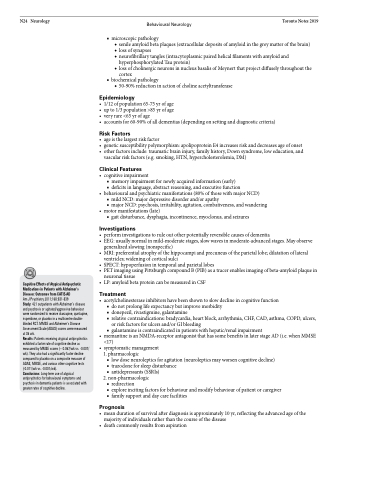Page 766 - TNFlipTest
P. 766
N24 Neurology
Behavioural Neurology Toronto Notes 2019
■ microscopic pathology
◆ senile amyloid beta plaques (extracellular deposits of amyloid in the grey matter of the brain) ◆ loss of synapses
◆ neurofibrillary tangles (intracytoplasmic paired helical filaments with amyloid and
hyperphosphorylated Tau protein)
◆ loss of cholinergic neurons in nucleus basalis of Meynert that project diffusely throughout the
cortex
■ biochemical pathology
◆ 50-90% reduction in action of choline acetyltransferase
Epidemiology
• 1/12ofpopulation65-75yrofage
• upto1/3population>85yrofage
• veryrare<65yrofage
• accountsfor60-90%ofalldementias(dependingonsettinganddiagnosticcriteria)
Risk Factors
• ageisthelargestriskfactor
• geneticsusceptibilitypolymorphism:apolipoproteinE4increasesriskanddecreasesageofonset • otherfactorsinclude:traumaticbraininjury,familyhistory,Downsyndrome,loweducation,and
vascular risk factors (e.g. smoking, HTN, hypercholesterolemia, DM)
Clinical Features
• cognitiveimpairment
■ memory impairment for newly acquired information (early)
■ deficits in language, abstract reasoning, and executive function
• behaviouralandpsychiatricmanifestations(80%ofthosewithmajorNCD)
■ mild NCD: major depressive disorder and/or apathy
■ major NCD: psychosis, irritability, agitation, combativeness, and wandering
• motormanifestations(late)
■ gait disturbance, dysphagia, incontinence, myoclonus, and seizures
Investigations
• performinvestigationstoruleoutotherpotentiallyreversiblecausesofdementia
• EEG:usuallynormalinmild-moderatestages,slowwavesinmoderate-advancedstages.Mayobserve
generalized slowing (nonspecific)
• MRI:preferentialatrophyofthehippocampiandprecuneusoftheparietallobe;dilatationoflateral
ventricles; widening of cortical sulci
• SPECT:hypoperfusionintemporalandparietallobes
• PETimagingusingPittsburghcompoundB(PIB)asatracerenablesimagingofbeta-amyloidplaquein
neuronal tissue
• LP:amyloidbetaproteincanbemeasuredinCSF
Treatment
• acetylcholinesteraseinhibitorshavebeenshowntoslowdeclineincognitivefunction
■ do not prolong life expectancy but improve morbidity
■ donepezil, rivastigmine, galantamine
■ relative contraindications: bradycardia, heart block, arrhythmia, CHF, CAD, asthma, COPD, ulcers,
or risk factors for ulcers and/or GI bleeding
■ galantamine is contraindicated in patients with hepatic/renal impairment
• memantineisanNMDA-receptorantagonistthathassomebenefitsinlaterstageAD(i.e.whenMMSE <17)
• symptomaticmanagement 1. pharmacologic
■ low dose neuroleptics for agitation (neuroleptics may worsen cognitive decline) ■ trazodone for sleep disturbance
■ antidepressants (SSRIs)
2. non-pharmacologic
■ redirection
■ explore inciting factors for behaviour and modify behaviour of patient or caregiver ■ family support and day care facilities
Prognosis
• meandurationofsurvivalafterdiagnosisisapproximately10yr,reflectingtheadvancedageofthe majority of individuals rather than the course of the disease
• deathcommonlyresultsfromaspiration
Cognitive Effects of Atypical Antipsychotic Medications in Patients with Alzheimer’s Disease: Outcomes from CATIE-AD
Am J Psychiatry 2011;168:831-839
Study: 421 outpatients with Alzheimer’s disease and psychosis or agitated/aggressive behaviour were randomized to receive olanzapine, quetiapine, risperidone, or placebo in a multicentre double- blinded RCT. MMSE and Alzheimer’s Disease Assessment Scale (ADAS) scores were measured at 36 wk.
Results: Patients receiving atypical antipsychotics exhibited a faster rate of cognitive decline as measured by MMSE scores (– 0.067/wk vs. -0.007/ wk). They also had a significantly faster decline compared to placebo on a composite measure of ADAS, MMSE, and various other cognitive tests (-0.011/wk vs. -0.001/wk).
Conclusions: Long-term use of atypical antipsychotics for behavioural symptoms and psychosis in dementia patients is associated with greater rates of cognitive decline.


